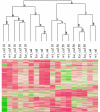Uncovering multiple molecular targets for caffeine using a drug target validation strategy combining A 2A receptor knockout mice with microarray profiling
- PMID: 19258493
- PMCID: PMC2685498
- DOI: 10.1152/physiolgenomics.90353.2008
Uncovering multiple molecular targets for caffeine using a drug target validation strategy combining A 2A receptor knockout mice with microarray profiling
Abstract
Caffeine is the most widely consumed psychoactive substance and has complex pharmacological actions in brain. In this study, we employed a novel drug target validation strategy to uncover the multiple molecular targets of caffeine using combined A(2A) receptor (A(2A)R) knockouts (KO) and microarray profiling. Caffeine (10 mg/kg) elicited a distinct profile of striatal gene expression in WT mice compared with that by A(2A)R gene deletion or by administering caffeine into A(2A)R KO mice. Thus, A(2A)Rs are required but not sufficient to elicit the striatal gene expression by caffeine (10 mg/kg). Caffeine (50 mg/kg) induced complex expression patterns with three distinct sets of striatal genes: 1) one subset overlapped with those elicited by genetic deletion of A(2A)Rs; 2) the second subset elicited by caffeine in WT as well as A(2A)R KO mice; and 3) the third subset elicited by caffeine only in A(2A)R KO mice. Furthermore, striatal gene sets elicited by the phosphodiesterase (PDE) inhibitor rolipram and the GABA(A) receptor antagonist bicucullin, overlapped with the distinct subsets of striatal genes elicited by caffeine (50 mg/kg) administered to A(2A)R KO mice. Finally, Gene Set Enrichment Analysis reveals that adipocyte differentiation/insulin signaling is highly enriched in the striatal gene sets elicited by both low and high doses of caffeine. The identification of these distinct striatal gene populations and their corresponding multiple molecular targets, including A(2A)R, non-A(2A)R (possibly A(1)Rs and pathways associated with PDE and GABA(A)R) and their interactions, and the cellular pathways affected by low and high doses of caffeine, provides molecular insights into the acute pharmacological effects of caffeine in the brain.
Figures



Similar articles
-
Acute and chronic caffeine administration differentially alters striatal gene expression in wild-type and adenosine A(2A) receptor-deficient mice.Synapse. 2001 Nov;42(2):63-76. doi: 10.1002/syn.1100. Synapse. 2001. PMID: 11574941
-
Physiological roles of A1 and A2A adenosine receptors in regulating heart rate, body temperature, and locomotion as revealed using knockout mice and caffeine.Am J Physiol Heart Circ Physiol. 2009 Apr;296(4):H1141-9. doi: 10.1152/ajpheart.00754.2008. Epub 2009 Feb 13. Am J Physiol Heart Circ Physiol. 2009. PMID: 19218506 Free PMC article.
-
Absence of quasi-morphine withdrawal syndrome in adenosine A2A receptor knockout mice.Psychopharmacology (Berl). 2006 Apr;185(2):160-8. doi: 10.1007/s00213-005-0284-0. Epub 2006 Feb 10. Psychopharmacology (Berl). 2006. PMID: 16470403
-
What knock-out animals tell us about the effects of caffeine.J Alzheimers Dis. 2010;20 Suppl 1:S17-24. doi: 10.3233/JAD-2010-1403. J Alzheimers Dis. 2010. PMID: 20182058 Review.
-
Effects of caffeine on striatal neurotransmission: focus on cannabinoid CB1 receptors.Mol Nutr Food Res. 2010 Apr;54(4):525-31. doi: 10.1002/mnfr.200900237. Mol Nutr Food Res. 2010. PMID: 20087854 Review.
Cited by
-
Adenosine hypothesis of schizophrenia--opportunities for pharmacotherapy.Neuropharmacology. 2012 Mar;62(3):1527-43. doi: 10.1016/j.neuropharm.2011.01.048. Epub 2011 Feb 17. Neuropharmacology. 2012. PMID: 21315743 Free PMC article. Review.
-
Alzheimer and Purinergic Signaling: Just a Matter of Inflammation?Cells. 2021 May 20;10(5):1267. doi: 10.3390/cells10051267. Cells. 2021. PMID: 34065393 Free PMC article. Review.
-
Neuromodulation and neuroprotective effects of chlorogenic acids in excitatory synapses of mouse hippocampal slices.Sci Rep. 2021 May 18;11(1):10488. doi: 10.1038/s41598-021-89964-0. Sci Rep. 2021. PMID: 34006978 Free PMC article.
-
Control of sleep and wakefulness.Physiol Rev. 2012 Jul;92(3):1087-187. doi: 10.1152/physrev.00032.2011. Physiol Rev. 2012. PMID: 22811426 Free PMC article. Review.
-
Caffeine intake exerts dual genome-wide effects on hippocampal metabolism and learning-dependent transcription.J Clin Invest. 2022 Jun 15;132(12):e149371. doi: 10.1172/JCI149371. J Clin Invest. 2022. PMID: 35536645 Free PMC article.
References
-
- Agardh EE, Carlsson S, Ahlbom A, Efendic S, Grill V, Hammar N, Hilding A, Ostenson CG. Coffee consumption, type 2 diabetes and impaired glucose tolerance in Swedish men and women. J Intern Med 255: 645–652, 2004. - PubMed
-
- Ascherio A, Zhang SM, Hernan MA, Kawachi I, Colditz GA, Speizer FE, Willett WC. Prospective study of caffeine consumption and risk of Parkinson's disease in men and women. Ann Neurol 50: 56–63, 2001. - PubMed
-
- Bracken MB, Triche EW, Belanger K, Hellenbrand K, Leaderer BP. Association of maternal caffeine consumption with decrements in fetal growth. Am J Epidemiol 157: 456–466, 2003. - PubMed
Publication types
MeSH terms
Substances
Grants and funding
LinkOut - more resources
Full Text Sources
Medical
Research Materials

